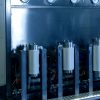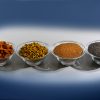
Our experience with algae
Exenia Group S.R.L. experiments with new technologies for the cultivation of various microalgal strains such as Nannochloropsis spp. Haematococcus spp. and Spirulina subsalsa. The value of the algal market has been increasing during the last 15 years, this is because microalgae are organisms that reproduce quickly reaching high biomass values. They also produce a rich amount of active chemicals, useful for our health such as Carotenoids, Vitamins and Antioxidants.
Exenia’s goal has always been to maximize algal growth in the shortest time possible, by designing innovative and computerized cultivation systems. Our photobioreactors are designed to have a surface that does not hinder the movement of the algal flow and as much as possible exposed to the light source. They are also equipped with probes for real-time pH and temperature values monitoring of the culture medium with the aim of monitoring the biological risk due to the growth of antagonistic microorganisms. Still under study, LED lights are proving suitable for maximizing chlorophyll photosynthesis and, at the same time, useful in inhibiting the growth of unwanted microorganisms, such as bacteria and protozoa, harmful to culture.
In recent years, attention to photosynthetic microorganisms has increased considerably primarily due to the rapid growth of the market for treatments and remedies/drugs of natural origin. In fact, the companies that produce food supplements of natural origin, natural drugs, cosmetic products, herbal products, homeopathic products constitutes a continuously growing market.
The economic data on the evolution of this macro sector indicate the persistence of growth even in contrast to situations of economic recession. Attention to microalgae can therefore be framed in the general interest in the cure/natural remedy.
In fact, these microorganisms, which represent the first forms of life on the planet, have a remarkable ability to live in extreme conditions: they are able to produce substances (carotenoids) to counteract the damage caused to the cell by UV rays, which particularly in primordial situations, represented a significant pitfall for survival because of a different atmosphere, less protective for primordial life.
So in microalgae we have the presence of antioxidant substances (e.g. astaxanthin in Haematococcus spp. Or beta-carotene in Dunaliella spp.) That allow protection from free radicals, responsible for initiating the peroxidation reactions, harmful to cell membranes.
Antioxidants block these chain reactions by intervening on the intermediate radicals and inhibiting other oxidation reactions, extinguishing the radicals through their own oxidation. For this action, antioxidants are chemically defined as reducing agents. Some microalgae are rich in polyunsaturated fatty acids ω-3 (ω-3 PUFA), natural antioxidants with multiple effects of emerging interest in various pathologies, including various neuropsychiatric diseases.
The ω-3 PUFAs are mainly produced from monocellular algae and are concentrated in various fish species, even if there are phytobiological sources. In particular, Eicosapentanoic acid (EPA) and Docosahexanoic acid (DHA) are the most important ω-3 for the treatment-prevention of different diseases in humans, and are produced by different microorganisms, in particular Nannocloropsis spp. which contains EPA (4% dry weight) and Isochrisis spp. which contains DHA (10% dry weight).
The annular reactors, as seen in the photo, are made of two concentric cylinders. The cultivation chamber formed between the two cylinders has a thickness that varies according to the microorganism that is to be cultivated and its need in terms of photons for cm2. The total height is over two meters.
The lights placed inside the internal cylinder generate a perfect isotropic light beam. Photons are not scattered and reach biomass, even with irradiation efficiency close to 100%. The gas added with CO2 reaches the biomass through the use of a dispersion ring which, thanks to its geometry, guarantees a constant air flow in all points without showing pressure drops.
This geometry used was developed through the Fitoplan system equipped with software for biological risk control: probes detect data relating to the cultivation pH, cell growth and presence of nitrogen substances.
In addition, control of LED lighting allows to vary the growth phase and to pass from the exponential growth phase of the cells to the phase of stasis and stress, fundamental for production of carotenoids.


